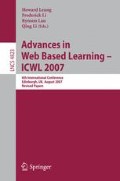Abstract
Children’s handwriting performance is a part of concern by parents, teachers and researchers, because learning to write is a major and critical task for children. An assessment tool capable of evaluating students’ handwriting automatically can help teachers to provide feedback to students and to find out more objectively the specific problems identified. In this paper, we propose an assessment tool for judging the overall appearance of the student’s Chinese handwriting by finding different geometric transformed parameters of a Chinese character with respect to a template character. By cross-validation with a team of occupational therapists who are more experienced in assessment of handwriting performance, it is hoped that a more reliable handwriting evaluation is received. The proposed tool has been integrated into a web-based system for assisting children to write correctly and precisely.
Access this chapter
Tax calculation will be finalised at checkout
Purchases are for personal use only
Preview
Unable to display preview. Download preview PDF.
References
Lam, C.C.C.: Developmental dyslexia. Public Health and Epidemiology Bulletin 12(1) (2003)
Opper, S.: Hong Kong’s Young Children: Their early development and learning. The Hong Kong University Book Press, Hong Kong (1996)
Mancini, M.C., Coster, W.J.: Functional Predictors of School Participation by Children with disabilities. Occupational Therapy International 11(1), 12–25 (2004)
Rosenblum, S., Parush, S., Weiss, P.L.: Computerized Temporal Handwriting Characteristics of Proficient and Non-Proficient Handwriters. The American Journal of Occupational Therapy 57(2), 129–138 (2003)
Preminger, F., Weiss, P.L., Weintraub, N.: Predicting Occupational Performance: Handwriting Versus Keyboarding. The American Journal of Occupational Therapy 58(2), 193–201 (2004)
Sutton Hamilton, S.: Evaluation of clumsiness in children. American Family Physician 66(8), 1435–1440 (2002)
Curriculum Development Council, HKSAR, CDC Chinese Language Education Key Learning Area Curriculum Guide (P1 - S3). HKSAR: Education and Manpower Bureau (2002)
Curriculum Development Institute, HKSAR, CDC Chinese Language Curriculum Guide (Primary 1-6). HKSAR: Education and Manpower Bureau (2004)
Education and Manpower Bureau, HKSAR. ebook: 《小一學生之學習情況量表》使用手冊。. The Hong Kong SAR Government, The Education and Manpower Bureau (2004) (Retrieved April 28, 2005), http://eii.emb.hkedcity.net/pdf/data01.01.pdf
Kulesh, V., Shaffer, K., Sethi, I., Schartz, M.: Handwriting Quality Evaluation. In: Proc. Intl. Conf. Advances in Pattern Recognition, pp. 157–165 (2001)
Djeziri, S., Guerfali, W., Plamondon, R., Robert, J.M.: Learning handwriting with pen-based systems: computational issues. Pattern Recognition 35(5), 1049–1057 (2002)
Robert, J.M., Djeziri S., Audet, M., Plamondon, R.: Scriptôt: pen-based software to support handwriting learning in primary schools, Technical Report, Ecole Polytechnique Montreal (1999)
Kim, D.H., Kim, E.-J., Bang, S.Y.: A Variation Measure for Handwritten Character Image Data Using Entropy Difference. Pattern Recognition 30(1), 19–29 (1997)
Ozaki, M., Adachi, Y., Ishii, N., Koyazu, T.: CAI System to Improve Hand Writing Skills by means of Fuzzy Theory. In: Proc. IEEE Intl. Conf. on Fuzzy Systems and the Second Intl. Fuzzy Engineering Symposium, pp. 491–496 (1995)
Chou, S.L., Yu, S.S.: Sorting Qualities of Handwritten Chinese Characters for Setting up a Research Database. In: Proc. Intl. Conf. on Document Analysis and Recognition, pp. 474–477 (1993)
Kato, T.: Evaluation System for hand-written characters. In: Kato, T. (ed.) Proc. Machine Vision Applications in Character Recognition and Industrial Inspection, pp. 73–82 (1992)
Leung, H., Komura, T.: Web-Based Handwriting Education with Animated Virtual Teacher. In: Liu, W., Shi, Y., Li, Q. (eds.) ICWL 2004. LNCS, vol. 3143, pp. 293–300. Springer, Heidelberg (2004)
Tang, K.-T., Li, K.K., Leung, H.: A Web-based Chinese Handwriting Education System with Automatic Feedback and Analysis. In: Liu, W., Li, Q., Lau, R.W.H. (eds.) ICWL 2006. LNCS, vol. 4181, pp. 176–188. Springer, Heidelberg (2006)
Tang, K.-T., Leung, H.: VACHE: A Ubiquitous Chinese Handwriting Education System. In: 1st International Conference on Ubiquitous Information Management and Communication
Tang, K.-T., Leung, H.: Reconstructing the Correct Writing Sequence from a Set of Chinese Character Strokes. In: Matsumoto, Y., et al. (eds.) ICCPOL 2006. LNCS (LNAI), vol. 4285, pp. 333–344. Springer, Heidelberg (2006)
Tang, K.-T., Leung, H.: Teaching Chinese Handwriting by Automatic Feedback and Analysis for Incorrect Stroke Sequence and Stroke Production Errors. In: 14th International Conference on Computers in Education (ICCE 2006), pp. 101–114 (2006)
Tsang, K., Leung, H.: Teaching Stroke Order for Chinese Characters by Using Minimal Feedback. In: Lau, R.W.H., et al. (eds.) ICWL 2005. LNCS, vol. 3583, pp. 135–145. Springer, Heidelberg (2005)
Tseng, M.-h.: Factorial Validity of the Tseng Handwriting Problem Checklist. J. Occup. Ther. Assoc. ROC 11, 13–27 (1993)
Burkard, R.E., Cela, E.: Linear Assignment Problems and Extensions. In: Pardalos, P.M., Du, D.-Z. (eds.) Handbook of Combinatorial Optimization, pp. 75–149. Kluwer Academic Publishers, Dordrecht (1999)
Author information
Authors and Affiliations
Editor information
Rights and permissions
Copyright information
© 2008 Springer-Verlag Berlin Heidelberg
About this paper
Cite this paper
Li, K.K., Leung, H., Lam, S., Li-Tsang, C. (2008). An Assessment Tool for Judging the Overall Appearance of Chinese Handwriting Based on Opinions from Occupational Therapists. In: Leung, H., Li, F., Lau, R., Li, Q. (eds) Advances in Web Based Learning – ICWL 2007. ICWL 2007. Lecture Notes in Computer Science, vol 4823. Springer, Berlin, Heidelberg. https://doi.org/10.1007/978-3-540-78139-4_26
Download citation
DOI: https://doi.org/10.1007/978-3-540-78139-4_26
Publisher Name: Springer, Berlin, Heidelberg
Print ISBN: 978-3-540-78138-7
Online ISBN: 978-3-540-78139-4
eBook Packages: Computer ScienceComputer Science (R0)

